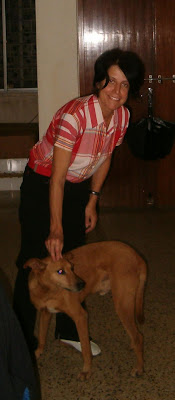Brindle 
Woof! I’m Brindle, the street dog who adopted Bunnylady and Jugfellow some years ago. The reason i’m writing this is because Jugfellow is too upset to write his column himself. Why? Because, once again, some misguided residents of the National Media Centre, the cooperative housing society near Gurgaon where we live, have started off on the so-called ‘stray dog menace’. This happens with unfailing regularity, not just in the NMC but also in that macrocosm of the NMC that we call India. From Kochi to Kolkata, Bagdogra to Bangalore, someone or the other will bring up the stray dog menace, causing a whole lot of innocent, perfectly harmless street dogs to be rounded up and, more often than not, put to death in the most inhumane and cruel manner. 
People never seem to understand that the Indian street dog (please don’t call us strays) are hardy, intelligent, affectionate creatures, often much more so that their pedigreed, imported counterparts, who have been viciously inbred by exploitative breeders. Street dogs have to be all these things in order to survive. Far from harming people, they are – when properly vaccinated against rabies and other diseases – man’s best pals, to coin a phrase. They act as excellent guards for the neighbourhood, alerting everyone to the intrusion of strangers by barking. Yet people keep on wanting to get rid of them. Not realising that nature abhors a vacuum and if you get rid of one lot of street dogs, another lot will inevitably take their place.
There is no such thing as a ‘stray dog menace’. There is only a ‘stray human menace’. Who is it that has strayed from the straight and narrow of God’s plan (and please don’t tell me that God is dog spelt backwards, because if i’ve heard that once i’ve heard it for the umpteenth time)?
Is it dogs, who live together amicably in the casteless, creedless democracy of doggydom, who have strayed? Or is it humans, with their caste conflicts and their religious wars, their whites and their blacks, their Hindus and Muslims and Sikhs and Christians, their Maoists and their monarchists, their Indias and their Pakistans, their terrorists and their victims, who are the real strays? And the real menace. Not only to each other, but to all of the rest of creation as well.
It wasn’t dogs who created 9/11, and 26/11, and al-Qaeda, and the Sri Lankan civil war, and the Taliban, and not one but two world wars. All these are human creations. And what wondrous creations. Can you imagine a dog creative enough to devise 65,000 nuclear warheads capable of killing every living creature on this planet a hundred times over? No. Only humans are creative enough to have done that. Though they have yet to prove themselves creative and clever enough to find a cure for the common cold. Or AIDS, or cancer, or a score of other killer diseases.
Humans have been too busy doing other things. Like polluting the planet and destroying its environment. The world’s forest cover has been thinned from 7.6 billion hectares in the pre-industrial age to 2.8 billion hectares. And that’s fast disappearing. Between 1700 and 1900, thanks to human activity, more than 20,000 species of plants, 593 species of birds, over 400 species of animals and 209 species of amphibians became extinct. Today, humans wipe out one species every day on an average. Tell me about the ‘stray dog menace’.
Unlike humans, who think the universe and everything in it was created only for their benefit to do with as they will, we dogs believe in the co-fraternity of all living things. And that includes cats. Cats? Oh, lor, what have Bunnylady and Jugfellow done? They’ve let Himal into the place. And Himal is a cat! Who insists on literally rubbing shoulders with me. Yuck. So, while there’s no such thing as a stray dog menace, if you were to talk about a stray cat menace, you might get me to agree. Or maybe not. For the basic dharma that doggydom teaches is to live and let live. Which means cats too. Where’s that damn Himal gone to…?
Web Linkshttp://blogs.timesofindia.indiatimes.com/jugglebandhi/
Contactsjug.suraiya@timesgroup.com
Printed without the permission of Jug Surai... I admire a lot and would like to recommend his books like JUGGLING ACT as compensation





















